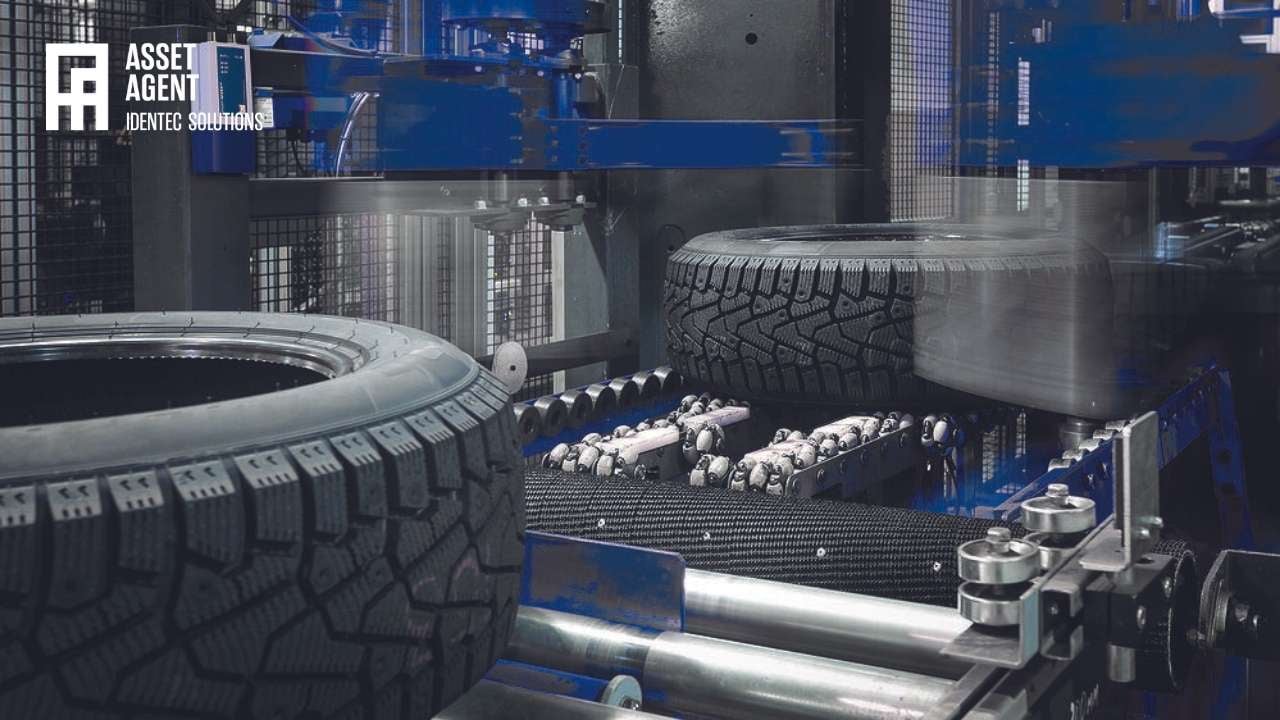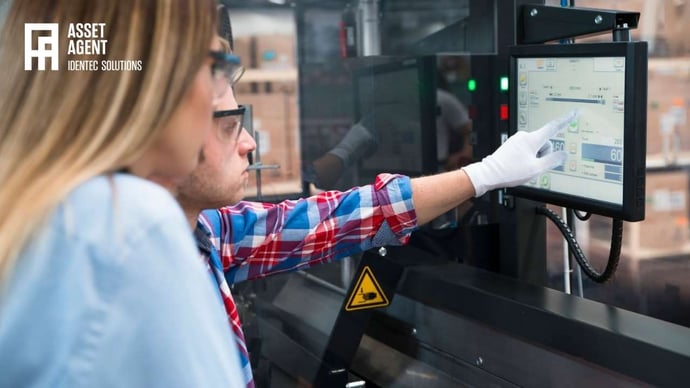Tyre Manufacturing: How to make digitalisation work
| Written by Dr. Urban Siller
Digitalisation is ubiquitous and is transforming manufacturing processes. But as for any other industrial investment: Improvements must be measurable. Digitalisation done right, can sustainably improve production Key Performance Indicators (KPI) in tyre manufacturing.

No video selected
Select a video type in the sidebar.
Digitalisation is quickly entering the tyre manufacturing industry, providing countless advantages that can sustainably improve production Key Performance Indicators (KPI). While barcode scanning has its advantages, digitalisation is the future for tyre manufacturing, offering a wide range of opportunities for improvement.
What are the Advantages of Barcode Scanning in Tyre Manufacturing?
Barcode scanning is revolutionizing the tyre manufacturing industry by providing an efficient and cost-effective way to track and manage production processes. By enabling the ability to quickly and accurately scan barcodes, manufacturers can significantly improve their accuracy, efficiency, and traceability, resulting in improved profitability and customer satisfaction.
Barcode scanning allows tyre manufacturers to leverage their existing investment in processes, technology, and equipment. By using barcodes to identify and label tyres, tires can be tracked throughout the production process, reducing the chances of errors and delays caused by manual data entry. Barcode scanning also makes it easier to track the location of parts and materials, providing manufacturers with real-time visibility into their production operations.
Barcode scanning can also help manufacturers streamline their processes through automated material handling, production scheduling, and inventory tracking. By incorporating barcodes into their processes, manufacturers can quickly identify and locate parts and components, reducing the time and effort associated with manual tracking. Additionally, barcode scanning technology can help manufacturers quickly track defects and errors during production, preventing costly mistakes and improving overall quality.
Moreover, barcode scanning can help tyre manufacturers effectively manage inventory levels, allowing them to optimize their supply chain and reduce unnecessary costs associated with over or understocking. By leveraging barcode scanning, manufacturers can quickly and easily access product information, giving them the data they need to make accurate and informed decisions regarding inventory levels.
Finally, barcode scanning is a cost-effective way to provide tire manufacturers with additional security and accountability. By scanning barcodes, manufacturers are able to ensure that all components are tracked and accounted for, making it easier to identify potential theft or discrepancies. Additionally, barcodes can enable access control, preventing unauthorized access to production areas or warehouses.
Interested in sustainability? Then continue reading our article about "What sustainable development goals drive the tire industry forward?"
What are the Disadvantages of Barcode Scanning in Tyre Manufacturing?
Barcode scanning is a widely used technology for tracking and organising tyres in manufacturing. While the technology offers many benefits, it also has several drawbacks.
One of the primary disadvantages of barcode scanning is its limited ability to store and access data. Barcode scanning can only store a limited amount of product information, and the data cannot be used for comprehensive analysis or reporting. Furthermore, the data is not automatically integrated with an existing database, meaning manual input is necessary in order to ensure accuracy.
In addition, barcode scanning is a relatively slow process, particularly when compared to newer, more advanced digitalisation technologies. Furthermore, barcode scanning is vulnerable to human error and can easily be disrupted by dirt, dust, or the poor printing quality. This means there is an increased risk of inaccurate information being transmitted, which can lead to problems with production timelines and quality.
Finally, barcode scanning can be expensive, as it requires specialised equipment that is not always easy or cost-effective to purchase and maintain. This can be a burden to companies, particularly small businesses, that are attempting to modernise their tyre manufacturing processes.
Digitalisation in Tyre Manufacturing
In the tyre manufacturing industry, digitalisation is revolutionising processes and providing a new level of efficiency and productivity. By digitizing processes and embracing the opportunities of digital technologies, tyre manufacturers can unlock their potential and remain competitive in a challenging global market.
Digitalisation enables tyre manufacturing companies to automate their processes, reduce their dependence on manual labour and gain real-time insights into the status and performance of the production line. Automation of production and quality control processes can lead to a reduction in costs, improve the accuracy and consistency of tyres produced and streamline the production cycle. Learn more about the production of a green tire.
The use of sensors, data loggers and robotic machinery can help tyre manufacturers to track the progress of a batch from start to finish and monitor the quality of tyres produced. Data-driven insights also enable manufacturers to identify and address any issues quickly, as well as identify areas for improvement.
In addition to the direct benefits of digitalisation, the capability for remote monitoring enables tyre manufacturers to make use of cloud computing and predictive analytics to optimise decision making. This allows for the assessment of production scheduling, supply chain processes and other areas of the business quickly and accurately.
The digitalisation of tyre manufacturing is still in its early stages, with most manufacturers yet to make the transition. By taking advantage of the opportunities of digitalisation, tyre manufacturers can unlock their potential, reduce costs and remain competitive in an ever-evolving market.
Read more about the concept of Industry 4.0 smart factory...
Advantages of Digitalisation in Tyre manufacturing
Digitalisation in tyre manufacturing has the potential to unlock an array of advantages. Digitalisation can help to simplify processes, reduce human error and increase the overall efficiency of tyre manufacturing. For example, data gathered through digitalisation can provide deeper insight into the production line and reveal any weak points or areas of improvement. This data can be used to optimise the entire production process, enabling faster production speeds, reduction of waste and even the development of new products. Furthermore, with digitalisation, tyre manufacturers can introduce new technologies to enhance the production process, including 3D printing or robotic arms, which can further increase operational efficiency. Most importantly, digitalisation can allow tyre manufacturers to uncover their full potential and exploit the possibilities of their existing resources (see for example Pick 2 Light).
Disadvantages of Digitalisation
Whilst digitalisation of the tyre manufacturing process does come with multiple advantages, there are a few drawbacks to be aware of. For instance, the upfront cost of digitisation can be quite high, depending on the necessary equipment, software and facilities that need to be installed in order for the process to run smoothly. This may be too costly for some tyre manufacturing businesses, meaning that they cannot benefit from the advantages that digitalisation brings.
Furthermore, digitalisation requires a high level of technical knowledge and skills to operate. If the staff of a tyre manufacturing business lack the necessary expertise to install and manage a digitalised process, this may lead to costly errors and even accidents in production. Therefore, it is important to ensure that the right personnel are in place to manage a digitalised workflow.
WHY DO WORKSHOP-TYPE OPERATIONS STILL RELY ON BARCODES, SCANNERS, PAPER AND PENCIL?
Digitalisation in production started with Programmable Logical Controllers (PLC’s) in 1969 and continued to increase the degree of automation ever since. The advantages of PLC’s over Connection Programmed Controllers (CPC’s) were so obvious that the investment into this modern technology seemed logical. Over time CPC’s got almost fully replaced by PLC’s.
Learn more about how an RTLS solution can help improve operational performance.
Digitalisation or the Industrial Internet of Things (IIoT) aims to replace barcodes and scanners as well as paper and pencil in manufacturing by making assets smart and connecting them to production control software. In short, the aim of IIoT is like the PLC revolution. So why is it that workshop-type operations still rely on barcodes and scanners and even paper and pencil more than 20 years after the announcement of the IIoT by Kevin Ashton in 1999?
The answer is simple: Most IIoT approaches never delivered measurable improvements of production KPIs (if you want to learn more, have a look here: How to record production data and experience real-time quality documentation)
At the same time, they suffered from low blue-collar user acceptance with simultaneously high monetary cost and engineering hours. The result of such an “investment” is easily predictable: After a long period of continuous frustration, management decides to give up on the project and reverts to status quo.
In order to reduce production cost in tyre manufacturing, any IIoT-based solution must help to increase machine utilisation, reduce scrap of raw materials, eliminate production errors of the final product and increase labour productivity.
IIoT-based solutions generate running cost, require maintenance, and sometimes user training. If the IIoT solution suffers from availability issues, is not user-friendly and easy to use by production personnel, doesn’t handle exceptions well and generates too many process deviations, users are going to bypass it and revert to existing processes such as barcodes and scanners or paper and pencil. In this case the IIoT solution makes production KPIs look worse as it only costs additional money and doesn’t deliver any KPI improvements at all.
Consequently, the approach to ask the IT department to “pick some hardware, program a few lines of code” and hand this custom “IIoT-solution” over to operations is certainly going to fail. Unfortunately, this approach is reality still too often.
WHY CHOOSING AN OFF-THE-SHELF-SOLUTION IS THE WAY FORWARD
The way forward is to choose an off-the-shelf IIoT solution, which is tailored to the needs of tyre manufacturing from hard- and software design (What is RTLS?) as well as IT and user interfaces. The chosen solution must be low in running cost, maintenance effort and ideally doesn’t require any training for blue-collar personnel at all. Learn more about Asset Agent and brownfield process optimization.
FAQs
What is IIoT?
Industrial Internet of Things (IIoT) is a network of connected physical devices and systems that enable data and information to be exchanged between them, allowing for improved communication and automation between machines, processes, and people.
Why is it important to optimise processes?
Optimising processes is important because it allows businesses to analyse data in real time and make decisions quickly, leading to increased efficiency, cost savings, and improved customer satisfaction.
What are some ways of optimising processes?
Some ways of optimising processes include using predictive analytics to anticipate potential problems, automating repetitive tasks, and using data to improve customer experience.
How can IIOT enable optimising processes?
IIoT enables optimising processes by providing real-time data from machines and systems that can be used to better understand customer needs, improve efficiency and accuracy, and automate mundane tasks.
Takeaway
In conclusion, digitalisation has been proven to be a successful investment in tyre manufacturing. It has a wide range of advantages over traditional methods, such as the ability to track tyre performance and reduce waste, as well as reduce the likelihood of human error. Additionally, it has created new opportunities for the tyre industry, such as the ability to use data-driven insights that allow improved decision-making.
Overall, digitalisation within tyre manufacturing is a powerful tool that can unlock the potential of tyre production. The continued investment and research into digitalisation will lead to better performance, quality and cost-efficiency. The journey to digitalise the tyre industry is a step-by-step process but one that will have substantial benefits for tyre manufacturers, consumers and the environment.
Continue reading the complete overview: Real time location systems in manufacturing and indoor logistics
Glossary
A green tyre refers to an uncured or unvulcanized tyre that has been assembled but not yet subjected to the heat and pressure required for vulcanization. At this stage, the tyre consists of all its raw components, including rubber, fabric, and steel belts, but lacks the final strength, elasticity, and durability achieved after curing. The green tyre is flexible and tacky, allowing easy adjustments before it undergoes the curing process in a mould. (3)
Sources:
(1) Lucas Santos Dalenogare, Guilherme Brittes Benitez, Néstor Fabián Ayala, Alejandro Germán Frank, The expected contribution of Industry 4.0 technologies for industrial performance, International Journal of Production Economics, Volume 204, 2018, Pages 383-394, ISSN 0925-5273,
https://doi.org/10.1016/j.ijpe.2018.08.019.
(2) F. Arcidiacono, A. Ancarani, C. D. Mauro and F. Schupp, "Where the Rubber Meets the Road. Industry 4.0 Among SMEs in the Automotive Sector," in IEEE Engineering Management Review, vol. 47, no. 4, pp. 86-93, 1 Fourthquarter, Dec. 2019, doi: 10.1109/EMR.2019.2932965
(3) Waddell, W. H., & Evans, L. R. (2013). The Science and Technology of Rubber (4th ed.). Elsevier.
Note: the article was updated on the 5th of February, 2025

Author
Dr. Urban Siller, CEO
Urban Siller is the CEO of IDENTEC SOLUTIONS, holding a PhD in Mechanical Engineering and a Master in Business Administration. Urban managed companies in the Supply Chain, Medical Device and Industrial Automation sectors for more than 25 years. His passion is to design innovative products & solutions that bring measurable benefits to customers. What makes his day is to experience how customers are using 'his' products & solutions, already thinking about new ways to serve them even better.





